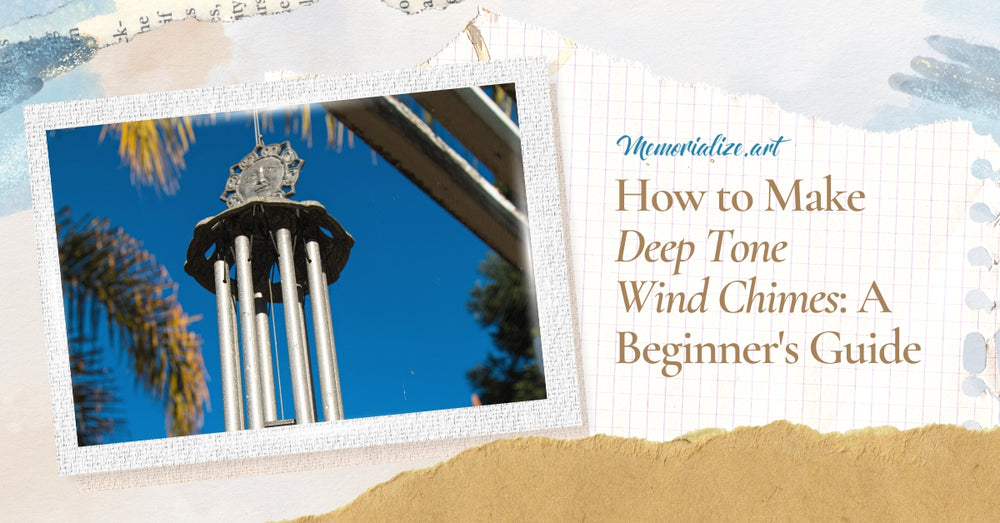How to Make Deep-Tone Wind Chimes: A Beginner's Guide

Wind chimes have fascinated people for centuries with their beautiful sounds and charm. While there are many different types, the deep-sounding wind chimes have a special magic. Their ability to produce rich, deep sound has a calming effect on anyone who hears it.
In this article, we'll discuss wind chimes, how to make deep-tone wind chimes, and why you should create one.
Understanding Wind Chimes

Wind chimes are decorative objects that create musical sounds when gusty winds move. The sound of wind chimes comes from the wind that carries a succession of tubes, rods, or other objects suspended in the air, causing them to hit each other or their central part.
When struck, each chime tube contributes a unique sound. Aside from using different materials for the rods, you may also include additional elements like bells, beads, or charms for added visual appeal.
Why Are Wind Chimes Popular?
The soft sounds of the wind chimes make for a relaxing and quiet atmosphere, which is a nice break from the busyness of everyday life.
Its beautiful melodies make people feel calm and relaxed, making it a popular choice for people who want to create a peaceful atmosphere. Additionally, it has become a part of many cultures, believing it can ward off evil spirits and negative energies away from homes.
Why You Should Create Your Wind Chimes

The Choice for Durable Materials
The types of wind chimes that can withstand weathering, corrosion, and fading will keep them functional for a long time. Your wind chime will continue to provide soothing music without constant maintenance.
Heavy chimes made from metal, bamboo, or a strong synthetic material will give your low-tone chime keep its beautiful appearance over time.
Personalization for Deeper Sound
You may customize the resonant sound of your wind chime by choosing different materials and adjusting other parts of the actual chime. Personalization allows you for an expert tuning the chime's characteristics. You may modify the distances between the chime tubes for a more harmonious sound.
Cost-Effective
If you decide to make your own chime set instead of commercial chimes, you can choose how much you want to spend on materials. You can make a tube wind chime using various inexpensive and easily sourced components, including metal or bamboo tubes, fishing line cords, and colorful beads. Doing this can charm your regular wind chimes and create an eye-catching design.
Common Materials Used For Wind Chimes
Metal Pipes
Aluminum tubing and copper tubing offer a distinctive and melodic sound that adds depth in deep bass-tone wind chimes. Metal's dense and solid nature allows for transmitting vibrations and generating sustained tones. This type of wind chime offers a distinctive, soothing sound that adds depth and elegance to any environment.
Wood Pieces
Natural materials are frequently used for low-tone wind chimes because they produce warm and earthy sounds. The sound produced by thicker, denser wood is typically lower in pitch than thinner, lighter wooden pieces. Bamboo chimes also create deep and resonant sounds because of their hollow structures, compared to glass wind chimes.
Making a Deeper Tone Wind Chime: Step-by-Step Guide
A wind chime design comes in various tones. You can craft a type of chime that produces resonant and calming tones, bringing tranquility and beauty to your surroundings. Chimes from scratch allow personalization, depending on how you want them to look and sound.
Prepare The Chime Tube
Choose the appropriate length for your piece of tubing based on the tone depth you wish to produce. Use a saw or pipe cutter to reduce its length and sandpaper to smooth off sharp corners.
Drilling Holes
Select a drill bit that matches the chime diameter of the hanging string you plan to use for your beautiful chimes. It should be slightly larger than the string to allow for easy threading. Choose a smaller-inch drill bit not to cause the tube to crack or splinter.
Create a Hanging Frame
Decide on the size and shape of your hanging frame based on the number of chime tubes and your desired design. It can be a block of wood, a circle, or any other shape that suits your preferences. Determine where you want to attach the decorative chime tubes to the base.
Attach The Chime Tube
Thread the fishing line or nylon cord through the holes in the tubes, tying knots to secure them in place. Run the lines through their respective holes in the bottom. Secure the tubes by tying knots at the bottom of the base.
Test The Sound
You can test your wind chime by gently shaking it or waiting for a light wind to blow through it once you've attached the tubes. Adjust the tubes' placement based on your hearing to get the deep bass tones you want.
Frequently Asked Questions
What determines the tone of wind chimes?
The pitch or tone produced is directly related to the length of the chime tubes. Lower-pitched tones generally result from longer tubes, whereas higher-pitched tones result from the shortest chime.
Can I customize the design of deep-sounding wind chimes?
Yes. Although there are many baritone wind chimes to choose from, you may also make your own by selecting the materials, colors, and ornamental components that you like best.
Do glass chimes produce low tones?
No. Glass wind chimes are known for their high pitch and delicate tones. Glass is better for making precise and bright sounds than deep or low ones because it resonates.
Shop Deep-Toned Wind Chimes at Memorialize Art and Experience The Tranquil Melodies
At Memorialize Art, we encourage you to look through our beautiful collection of deep-tone wind chimes and get lost in their soothing melodies. With various styles and materials, you can find the perfect wind chime to match your style and create an interesting mood.










